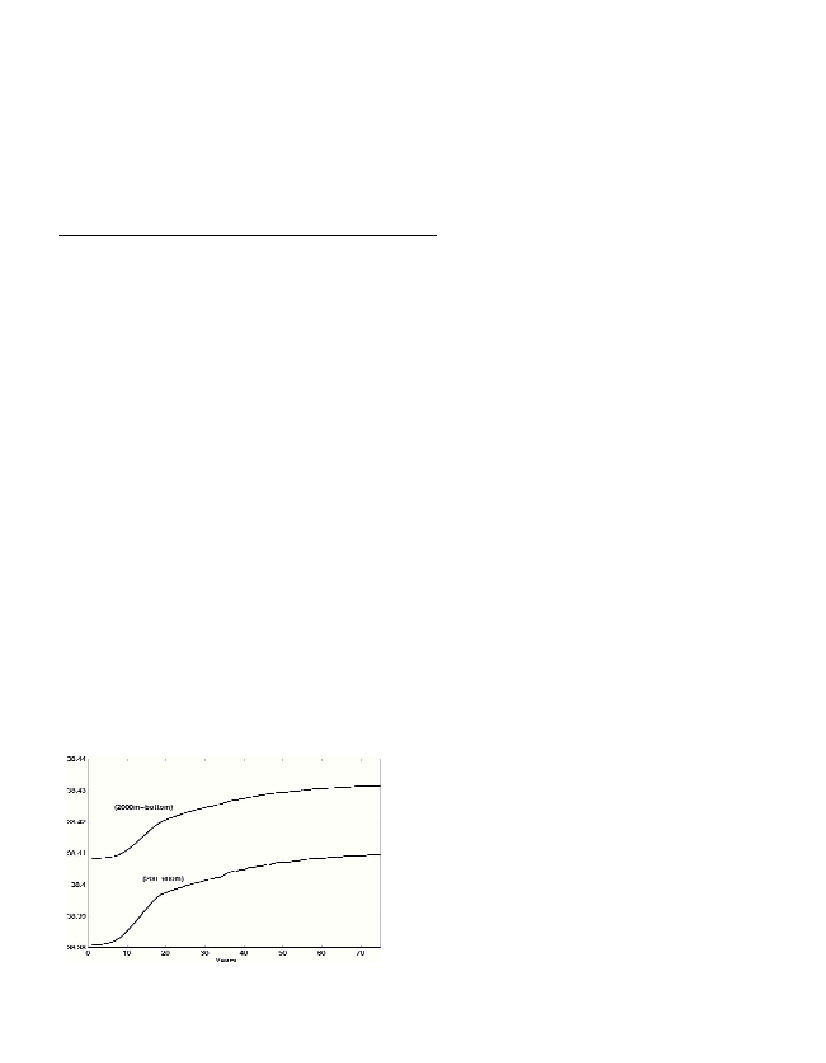Rapp. Comm. int. Mer Médit., 37,2004
141
MODELLING THE IMPACT OF THE NILE DAMMING
ON THE MEDITERRANEAN THERMOHALINE CIRCULATION
N. Skliris*, A. Lascaratos, and S. Sofianos
Ocean Physics And Modeling Group, University of Athens, University Campus, Phys-V, 15784 Athens, Greece
Abstract
Changes in the Mediterranean intermediate/deep water characteristics are investigated in relation to the Nile damming in a process-
oriented study. Results show that the drastic Nile runoff reduction induced a large salinity increase in the Levantine surface layer in the
sixties/seventies, which enhanced the LIW production rates and salinity. This in turn resulted in the production of saltier and larger
amounts of deep waters in the Adriatic and the Gulf of Lions. It also functioned as a strong preconditioning to the formation of deep waters
in the Southern Aegean (EMT), following two very cold winters in the early 90’s.
Keywords: Numerical modelling; river discharge; thermohaline circulation
Introduction
After building the Aswan Dam in 1964, the runoff of the Nile was
drastically reduced (by more than 90%), affecting the salt budget of
the Mediterranean Sea. Important changes in the characteristics of the
deep waters of both the Eastern and Western Mediterranean basins
during the last four decades have been associated with this event [1,
2]. The response of the Mediterranean Sea and the various sub-basins
to the Nile damming is investigated in this study, using the POM
model. The results are compared with previous studies and
observational data, and mechanisms involved in changes of the deep
water mass characteristics are investigated.
Results and discussion
The model is first integrated using climatological atmospheric
forcing, derived from the ECMWF reanalysis, and values of the Nile
runoff typical of the pre-damming period and reaches a steady state
after 75 years of integration. Then the model is integrated using the
reduced runoff values, typical of the after-damming period, to reach a
new steady state (after 75 years of integration). Results show that the
Nile damming induced a large increase in the surface layer salinity in
the Aegean and Levantine basins exceeding 0.1 psu in the early
seventies, in agreement with observations [1]. This saltier surface
layer in the vicinity of the Rhodes Gyre favoured the preconditioning
for the formation of the LIW, resulting in about 30% increase of its
formation rate. Intermediate waters became saltier, and as they were
transported westward they reduced the stability of the water column
in the deep-water formation sites, namely the Southern Aegean, the
Southern Adriatic and the Gulf of Lions. Thus saltier and larger
amounts of dense waters were formed filling the deep parts of the
Mediterranean. Salinity changes become perceptible in the deep
layers of the western basin about 7-8 years after the Nile damming
(Fig. 1) when the increased salinity signal reaches the Gulf of Lions
via the LIW circulation. Results indicate that the Nile damming
explains about 45% of the observed salinity increasing trend during
the last 40 years in the WMDW. This trend is rapidly slowing down
after 20 years of simulation and is almost vanished by about 2030
when a new quasi-steady state of the Mediterranean thermohaline
circulation is reached. The time-scale of the Mediterranean system
response to the Nile damming is in agreement with simplified box
model results [2]. Furthermore, results demonstrate that the Nile
damming played an important role in the long-term salt
preconditioning of the surface/intermediate layers of the Cretan and
Levantine Seas, contributing in triggering the two eastern
Mediterranean transients [1]. Although the results indicate an increase
in the deep layer salinity the model is not able to reproduce the large
salinity increasing trends in the Levantine deep waters during the two
transients.
To investigate the effect of surface cooling, the experiment was
repeated imposing a -1ºC drop in the SST in the Levantine for ten
years corresponding to 1965-1975 (when a continuous decrease in the
mean winter SST of the Levantine is observed in the data [3]) and a -
2ºC drop in the SST of the Aegean during the winters of 1992 and
1993. Results show that during the first period LIW formation occurs
in a larger area of the northern Levantine whereas deep water
formation occurs now inside the Rhodes Gyre, propagating the
signature of increased salinity towards the deep layers of the
Levantine. Similarly, the intense surface cooling related to the cold
winters of 1992 and 1993 was found to play a crucial role in the
second transient, increasing the Cretan Deep Water formation rate by
an order of magnitude. The newly formed water, which out?ows from
the Cretan Arc straits, is much more saline and warmer than the
previous existing EMDW resulting in large increasing trends in both
the temperature and salinity of the deep layers.
References
1-Theocharis A., Lascaratos A., and Sofianos S., 2002. Variability of sea
water properties in the Ionian, Cretan and Levantine seas during the last
century. CIESM Workshop Series,16: 71-74.
2-Bethoux J.P., and Gentili B., 1999. Functioning of the Mediterranean
Sea: past and present changes related to freshwater input and climate
changes. J. Mar. Syst.,20: 33-47.
3-Lascaratos A., Sofianos S., and Korres G., 2002. Interannual variability
of atmospheric parameters over the Mediterranean basin from 1945 to
1994. CIESM Workshop Series, 16: 21-23.
Fig. 1. Evolution of the model annual mean salinity (psu) in the Western
Mediterranean basin after the Nile damming for the layers: 200-600m
and 2000m-bottom.

